Section 2.3. Extension Headers
2.3. Extension HeadersThe IPv4 header can be extended from a minimum of 20 bytes to a maximum of 60 bytes in order to specify options such as Security Options, Source Routing, or Timestamping. This capacity has rarely been used because it causes a performance hit. For example, IPv4 hardware forwarding implementations have to pass the packet containing options to the main processor (software handling). The simpler a packet header, the faster the processing is. IPv6 has a new way to deal with options that has substantially improved processing: it handles options in additional headers called Extension headers. Extension headers are inserted into a packet only if the options are needed. The current IPv6 specification (RFC 2460) defines six Extension headers:
There can be zero, one, or more than one Extension header in an IPv6 packet. Extension headers are placed between the IPv6 header and the upper-layer protocol header. Each Extension header is identified by the Next Header field in the preceding header. The Extension headers are examined or processed only by the node identified in the Destination address field of the IPv6 header. If the address in the Destination address field is a multicast address, the Extension headers are examined and processed by all the nodes belonging to that multicast group. Extension headers must be strictly processed in the order in which they appear in the packet header. There is one exception to the rule that only the destination node will process an Extension header. If the Extension header is a Hop-by-Hop Options header, the information it carries must be examined and processed by every node along the path of the packet. The Hop-by-Hop Options header, if present, must immediately follow the IPv6 header. It is indicated by the value 0 in the Next Header field of the IPv6 header (see Table 2-1 earlier in this chapter).
This architecture is very flexible for developing additional Extension headers for future uses as needed. New Extension headers can be defined and used without changing the IPv6 header. A good example is the Mobility header defined for Mobile IPv6 (RFC 3775), which is discussed in Chapter 11. Figure 2-3 shows how Extension headers are used. Figure 2-3. The use of Extension headers Each Extension header's length is a multiple of eight bytes so that subsequent headers can always be aligned. If a node is required to process the next header but cannot identify the value in the Next Header field, it is required to discard the packet and send an ICMPv6 Parameter Problem message back to the source of the packet. (For details on ICMPv6 messages, refer to Chapter 4.) If more than one Extension header is used in a single packet, the following header order should be used (RFC 2460):
In cases when IPv6 is encapsulated in IPv4, the Upper-Layer header can be another IPv6 header and can contain Extension headers that have to follow the same rules. 2.3.1. Hop-by-Hop Options HeaderThe Hop-by-Hop Options header carries optional information that must be examined by every node along the path of the packet. It must immediately follow the IPv6 header and is indicated by a Next Header value of 0. For example, the Router Alert (RFC 2711) uses the Hop-by-Hop Options header for protocols such as Resource Reservation Protocol (RSVP) or Multicast Listener Discovery (MLD) messages. With IPv4, the only way for a router to determine whether it needs to examine a datagram is to at least partially parse upper-layer data in all datagrams. This process slows down the routing process substantially. With IPv6, in the absence of a Hop-by-Hop Options header, a router knows that it does not need to process router-specific information and can route the packet immediately to the final destination. If there is a Hop-by-Hop Options header, the router needs only to examine this header and does not have to look further into the packet. The format of the Hop-by-Hop Options header is shown in Figure 2-4. Figure 2-4. Format of the Hop-by-Hop Options header The following list describes each field:
The Option Type Field, the first byte of the Options fields, contains information about how this option must be treated in case the processing node does not recognize the option. The value of the first two bits specifies the actions to be taken:
The third bit of the Options Type field specifies whether the option information can change en route (value 1) or does not change en route (value 0). 2.3.1.1. Option Type JumbogramThis Hop-by-Hop Option Type supports the sending of IPv6 Jumbograms. The IPv6 Payload Length field supports a maximum packet size of 65,535 bytes. The Jumbo Payload Option (RFC 2675) allows for larger packets to be sent. In the IPv6 header of a packet with the Jumbo Payload option, the Payload Length field is set to 0. The Next Header field contains the value 0, which indicates a Hop-by-Hop Options header. The Option Type value of 194 indicates the Jumbo Payload option. The Jumbo Payload Length field has 32 bits and therefore supports the transmission of packets that are between 65,536 and 4,294,967,295 bytes. RFC 2675 also defines extensions to UDP and TCP that have to be implemented on hosts that need to support the sending of Jumbograms. 2.3.1.2. Option Router AlertThis option type indicates to the router that the packet contains important information to be processed when forwarding the packet. The option is currently used mostly for MLD (Multicast Listener Discovery) and RSVP (Resource Reservation Protocol). It is specified in RFC 2711. RSVP uses control packets containing information that needs to be interpreted or updated by routers along the path. These control packets use a Hop-by-Hop Options header, so only routers process the packet. Regular data packets do not have this Extension header and are therefore forwarded immediately without further inspection by the router. The first 3 bits of the Option Type field are set to 0. A router that doesn't know this option ignores it and forwards the packet. In the remaining 5 bits of the first byte, the option type 5 is specified. The Option Data Length field contains the value 2, which indicates that the following value field has a length of 2 bytes (refer to Figure 2-4). RFC 2711 defines the following values for the value field:
2.3.2. Routing HeaderThe Routing header is used to give a list of one or more intermediate nodes that should be visited on the packet's path to its destination. In the IPv4 world, this is called the "Loose Source and Record Route" option. The Routing header is identified by a Next Header value of 43 in the preceding header. Figure 2-5 shows the format of the Routing header. Figure 2-5. Format of the Routing header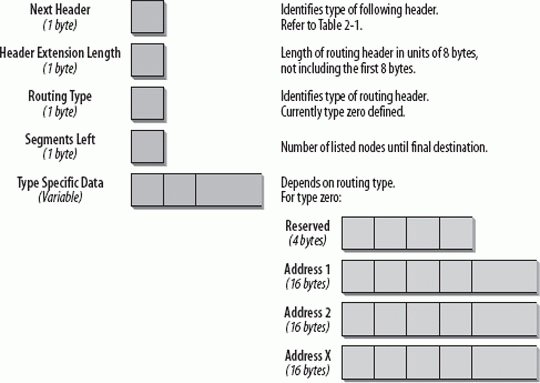 The following list describes each field:
If a node processing a Routing header cannot identify a Routing Type value, the action taken depends on the content of the Segments Left field. If the Segments Left field does not contain any nodes to be visited, the node must ignore the Routing header and process the next header in the packet, which is determined by the Next Header field's value. If the Segments Left field is not zero, the node must discard the packet and send an ICMP Parameter Problem, Code 0 message to the packet's Source address pointing to the unrecognized Routing Type. If a forwarding node cannot process the packet because the next link MTU size is too small, it discards the packet and sends an ICMP Packet Too Big message back to the source of the packet. The only Routing Type described in RFC 2460 is a Type 0 Routing header. The first node that processes the Routing header is the node addressed by the Destination address field in the IPv6 header. This node decrements the Segments Left field by one and inserts the next address field from within the Routing header in the IPv6 header Destination address field. Then the packet is forwarded to the next hop that will again process the Routing header as described until the final destination is reached. The final destination is the last address in the Routing Header Data field. Refer to Chapter 11 to find out how the Routing header is used for Mobility. Figure 2-6 shows the Routing header in a trace file. Figure 2-6. Routing header in a trace file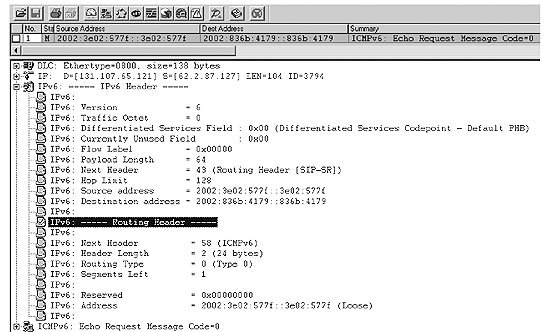 The Next Header field within the IPv6 header shows the value 43 for the Routing header. The Source and Destination addresses have the prefix 2002, which is allocated to 6to4 sites (6to4 is a transition mechanism described in Chapter 10). The Routing header contains the fields discussed earlier in this section. Next Header is ICMPv6, indicated by the value 58. The Header Length contains two 8-byte units, which add up to a total length of 16 bytes (one address). The Segments Left field contains the value 1 because there is one address entry in the Options field. Finally, the Options field lists the addresses to be visited. In this case, there is only one entry. If several hosts are listed here, every forwarding node (that is, the destination IP address in the IPv6 header) takes the next entry from this host list, uses it as a new destination IP address in the IPv6 header, decrements the Segments Left field by one, and forwards the packet. This is done until it reaches the last host in the list. A source node S sends a packet to destination node D using a Routing header to send the packet through the intermediate nodes I1, I2, and I3. See the Routing header changes in Table 2-2 (example taken from RFC 2460).
2.3.3. Fragment HeaderAn IPv6 host that wants to send a packet to an IPv6 destination uses Path MTU discovery to determine the maximum packet size that can be used on the path to that destination. If the packet to be sent is larger than the supported MTU, the source host fragments the packet. Unlike in IPv4, with IPv6 a router along the path does not fragment packets. Fragmentation occurs only at the source host sending the packet. The destination host handles reassembly. A Fragment header is identified by a Next Header value of 44 in the preceding header. The format of the Fragment header is shown in Figure 2-7. Figure 2-7. Format of the Fragment header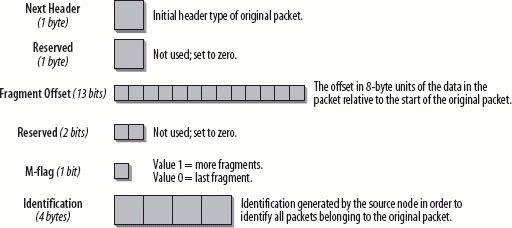 The following list describes each field:
The initial unfragmented packet is referred to as the original packet. It has an unfragmentable part that consists of the IPv6 header plus any Extension headers that must be processed by nodes along the path to the destination (i.e., Hop-by-Hop Options header). The fragmentable part of the original packet consists of any Extension headers that need only to be processed by the final destination, plus the upper-layer headers and any data. Figure 2-8 (RFC 2460) illustrates the fragmenting process. Figure 2-8. Fragmentation with IPv6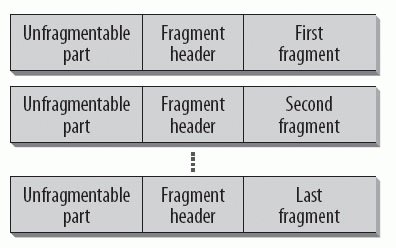 The unfragmentable part of the original packet appears in every fragment, followed by the Fragmentation header and then the fragmentable data. The IPv6 header of the original packet has to be slightly modified. The length field reflects the length of the fragment (excluding the IPv6 header) and not the length of the original packet. The destination node collects all the fragments and reassembles them. The fragments must have identical Source and Destination addresses and the same identification value in order to be reassembled. If all fragments do not arrive at the destination within 60 seconds after the first fragment, the destination will discard all packets. If the destination has received the first fragment (offset = zero), it sends back an ICMPv6 Fragment Reassembly Time Exceeded message to the source. Figure 2-9 shows a Fragment header. Figure 2-9. Fragment header in a trace file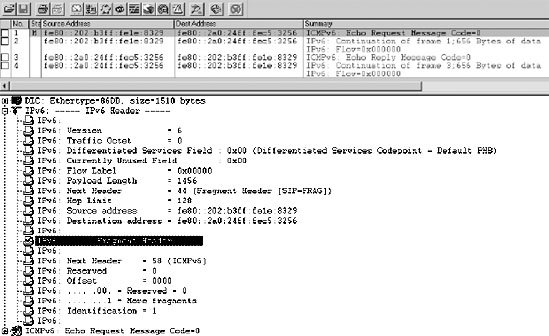 I created this Fragment header by generating an oversized ping from Marvin to Ford (Windows to Linux). The whole fragment set consists of two packets, the first of which is shown in Figure 2-9. In the IPv6 header, the Payload Length field has a value of 1456, which is the length of the fragmentation header and this one fragment, not the length of the whole original packet. The Next Header field specifies the value 44, which is the value for the Fragment header. This field is followed by the Hop Limit field and the Source and Destination IP addresses. The first field in the Fragment header is the Next Header field. Because this is a ping, it contains the value 58 for ICMPv6. And because this is the first packet in the fragment set, the value in the Offset field is 0 and the M-Flag is set to 1, which means there are more fragments to come. The Identification field is set to 1 and has to be identical in all packets belonging to this fragment set. Figure 2-10 shows the second packet of the fragment set. Figure 2-10. The second and last packet in the fragment set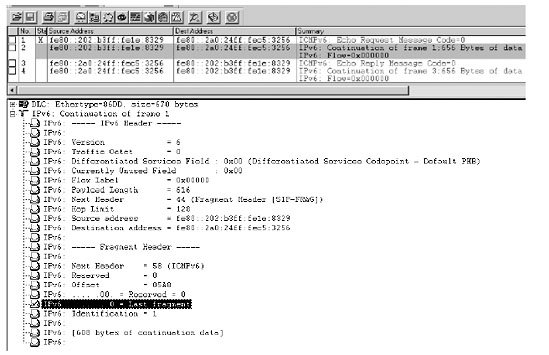 The second and last packet of this fragment set has an Offset value of 0x05A8, which translates to 1448 in decimal notation, the length of the first fragment. The M-Flag is set to 0, which indicates that it is the last packet and tells the receiving host that it is time to reassemble the fragments. The Identification field is set to 1 in both packets. 2.3.4. Destination Options HeaderA Destination Options header carries optional information that is examined by the destination node only (the Destination address in the IPv6 header). A Next Header value of 60 identifies this type of header. As mentioned previously, the Destination Options header can appear twice in an IPv6 packet. When inserted before a Routing header, it contains information to be processed by the routers listed in the Routing header. When inserted before the upper-layer protocol headers, it contains information for the final destination of the packet. Figure 2-11 shows the format of the Destination Options header. Figure 2-11. Format of the Destination Options header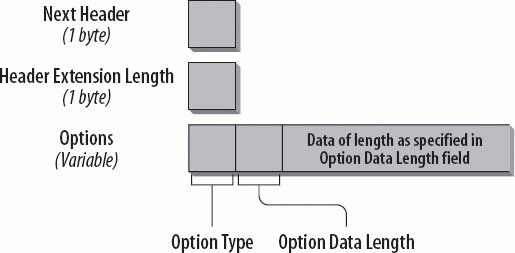 As you can see, the format is similar to the format of the Hop-by-Hop Options header. The following list describes each field:
The Options field is used in the same way as the Hop-by-Hop Options header, which I discussed earlier in this chapter. An example of the use of the Destination Options header is Mobile IPv6. You can find a detailed description of Mobile IPv6 in Chapter 11. Now that you understand the IPv6 header, read Chapter 3, which describes the IPv6 addressing architecture. |
